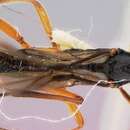Distribution
provided by Catalog of Hymenoptera in America North of Mexico
Nebr., Colo.
- bibliographic citation
- Catalog of Hymenoptera in America North of Mexico. 1979. Prepared cooperatively by specialists on the various groups of Hymenoptera under the direction of Karl V. Krombein and Paul D. Hurd, Jr., Smithsonian Institution, and David R. Smith and B. D. Burks, Systematic Entomology Laboratory, Insect Identification and Beneficial Insect Introduction Institute. Science and Education Administration, United States Department of Agriculture.
Comprehensive Description
provided by Smithsonian Contributions to Zoology
Orgilus alacer
This species very closely resembles politus, new species, from which it differs, however, in the presence of some sculpture on the first and second tergites of the abdomen, and in the more strongly sculptured propodeum, darker wings, and relatively shorter lower abscissa of basella.
FEMALE.—Length about 5 mm. Head barely wider than thorax and about 0.6 as long as wide in dorsal view; face only slightly wider than eye height (in ratio of 75:70), very shiny, and finely punctate, the punctures for the most part about a puncture width apart; malar space shagreened and rather dull, about 0.4 as long as eye height, longer than clypeus but slightly shorter than longest segment of maxillary palpus; only lower part of cheeks shagreened and rather mat; temples about 0.85 as wide as eyes, smooth and shiny, occipital carina only narrowly interrupted medially; frons and vertex smooth and shiny; ocellocular line hardly twice as long as diameter of an ocellus; antennae of holotype 37-segmented, a few of the preapical flagellar segments about as broad as long.
Mesoscutum very shiny, with only some minute and shallow setigerous punctures; notauli deep and fine, finely foveolate and meeting in a strongly rugulose and narrowly triangular area just before apex of scutum; disc of scutellum very shiny, rather flat; prescutellar sulcus deep but weakly foveolate; propodeum entirely rugulose except for a small smooth and polished area each side at extreme base, the stubs of the longitudinal carinae that arise from the posterior margin very short and rather weak; side of pronotum largely finely rugulose and shiny; mesopleuron smooth and polished except for a small area below tegula which is rugulose, the longitudinal furrow a little sinuate and completely, strongly foveolate; metapleuron shiny, closely and shallowly punctate, rugulose at the lower posterior margin. Hind coxa smooth and shiny, 0.65 as long as hind femur, which is 4.5 times as long as wide; inner calcarium of hind tibia clearly less than half as long as metatarsus; tarsal claws simple. Radial cell on wing margin as long as stigma; second abscissa of radius on a line with intercubitus; stub of third abscissa of cubitus longer than second abscissa; nervulus postfurcal by about one-third of its length; hind wing very nearly five times as long as wide; lower abscissa of basella not longer than nervellus and much less than half as long as mediella.
Abdomen as long as head and thorax combined; first tergite about 1.3 times as long as broad at apex, the spiracles more than twice as far from apex as from base, the dorsal keels not developed, the surface of the tergite smooth at base and at apex and very narrowly along the middle, but longitudinally rugulose laterally; second tergite about as long as broad at base, smooth and shiny except for a small confluently punctate area each side of middle at base; remainder of the abdomen smooth and polished; ovipositor sheath a little longer than head, thorax, and abdomen combined.
Deep black; clypeus, palpi and antennae all entirely black; tegulae black, wing bases piceous; wings distinctly somewhat infumated; all coxae, trochanters, and femora yellow, the forefemora a little darkened on the upper edges and the hind femora at extreme apices; middle and hind tibiae a little darkened toward apices, and all tarsi dark; abdomen black above and below.
MALE.—None included in the type material.
HOLOTYPE.—USNM 70140.
DISTRIBUTION.—Described from the holotype female collected in Boulder Canyon, Colorado, at 7800 feet, 8 August 1960, by R. and K. Dreisbach. The United States National Museum has a male from Custer County, Nebraska, collected by R. R. Dreisbach, 21 August 1951, which I believe to be the same species. It appears to agree in all essential respects. The antennae are 38-segmented.
- bibliographic citation
- Muesebeck, Carl F. W. 1970. "The Nearctic species of Orgilus Haliday (Hymenoptera: Braconidae)." Smithsonian Contributions to Zoology. 1-104. https://doi.org/10.5479/si.00810282.30

